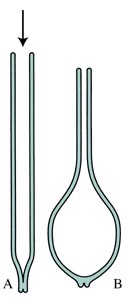- Glass Making in Roman Times
- Roman Wine: A Window on an Ancient Economy
- Roman Wine: Windows on a Lifestyle
- Fine Glassware in the Roman World
- Reuse of Images in the Art of Rogier van der Weyden
The Origins of Glassworking

Ht., 8.3 cm
Early 1st century B.C.
Jewish Quarter
Jerusalem's Old City

The Steps of Invention
Introduction
Even though Roman merchants were in close contact with the Hellenistic world by the early 2nd century B.C., they and several generations of their successors took little or no interest in glass. The first use of a Latin word for itvitrumoccurs quite late, around 65 B.C., in the On the Nature of Things, by the poet Lucretius, as he tried to explain how glass' most vital property of translucency set it apart from other materials.
A couple of years before Lucretius penned these ideas, however, a craftsman in Jerusalem had realized that, if you took one of the glass tubes which for centuries had been the stock for mass production of beads and sealed it at one end (step A), then blew into it, you could create a glass bulb (step B). If you blew hard enough and long enough, you would create a small bottle. Herein lay the origins of glassblowing, the technology that, up to recent decades, has dominated the domestic side of modern glassmaking. It also was the technology that provided Roman glassworking with its commercial viability.
